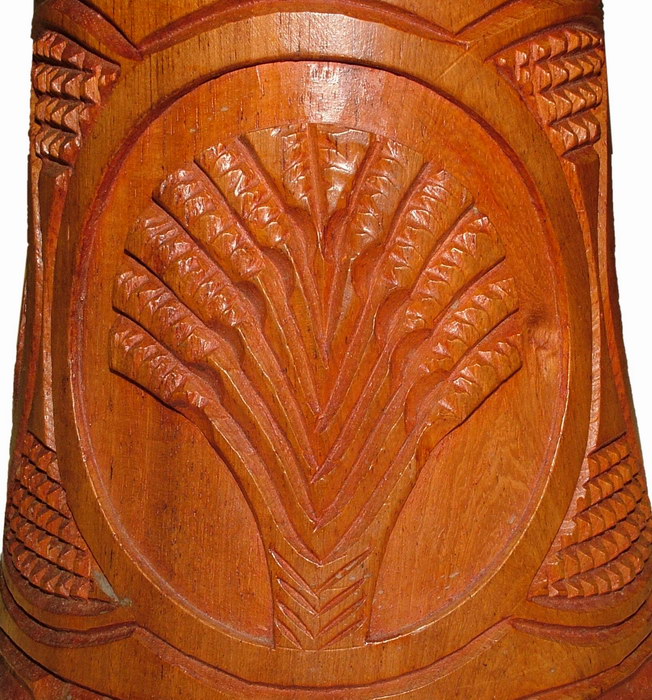Traditional arts were definitely dependent on the
materials readily available. Silk and cloth weaving are necessary skills for
the creation of the lamba cloths (the traditional cloth that is wrapped around
the body). Embroidery and sewing arts also go hand-in-hand with the weaving
arts. Raffia weaving is integral to Malagasy arts and is used to make a
variety of items used in housewares, such as baskets and mats. Raffia is also
used in textiles such as bags, purses, and hats.
 |
| Side of djembe drum |
Woodcarving, a common art form throughout Africa,
is a highly developed form of art on Madagascar. Many of these decorative
skills are found on furniture and in home building. Sculptors vary their skills
between functional sculptures like furniture and funeral posts to smaller
carvings aimed for the tourist market. The Zafimaniry are especially known for
their wood carving skills; it made the UNESCO Intangible Cultural Heritage
list.
 |
| Women Grooming, by Dzery |
In the urban areas, art galleries are popping up
here and there. It’s still a small number, but it’s growing. Local painters are
gaining recognition in their communities through these galleries as painting
arts gain popularity.
Literature in Madagascar is mainly written in
Malagasy, a language that is synonymous with its national identity. The
earliest examples of writings from Madagascar were mainly religious in nature
and written using an Arabic script called sorabe
adapted specifically for the Malagasy language.
At the beginning of the 20th century
after the French colonization of the island, a Western style of literature
began to emerge among writers. The early part of their modern literary history
(1906-1938) is divided into four phases with these poetically named periods: 1)
learning to walk, 2) nostalgia, 3) a return to origins, and 4) the search for
what’s been lost. Through these periods, Malagasy writers not only developed
their own writing styles but also developed their voices as a people. For many,
a national identity was formed in the struggles of colonialism and a national
voice began to be heard.
 |
| Jean-Joseph Rabearivelo. Rough translation: "Reflections, a silent dream / Almost no vibration / Glide, to where? crossing, / And which? Not found ..." |
The great poet Jean-Joseph Rabearivelo is often
touted as Africa’s first modern poet. What made his work different from others
at that time was his ability to merge romantic, modernist, and surrealist
styles of poetry with key features of Malagasy oratory. He didn’t just write
poetry: he also wrote several historical novels and even an opera. His suicide
by cyanide in 1937 also contributed to immortalizing his works.
Jean-Joseph Rabearivelo paved the way for other modern
Malagasy writers: Elie Rajaonarison (poet), Jacques Rabemananjara (poet,
playwright, politician), Jean Verdi Salomon Razakandrainy (also known as Dox,
poet and writer), Jean-Luc Raharimanana (writer, journalist, teacher), Clarisse
Ratsifandrihamanana (writer, recipient of seven literary prizes), and Michèle
Rakotoson (film maker, writer, journalist).
Up next: music and dance




No comments:
Post a Comment